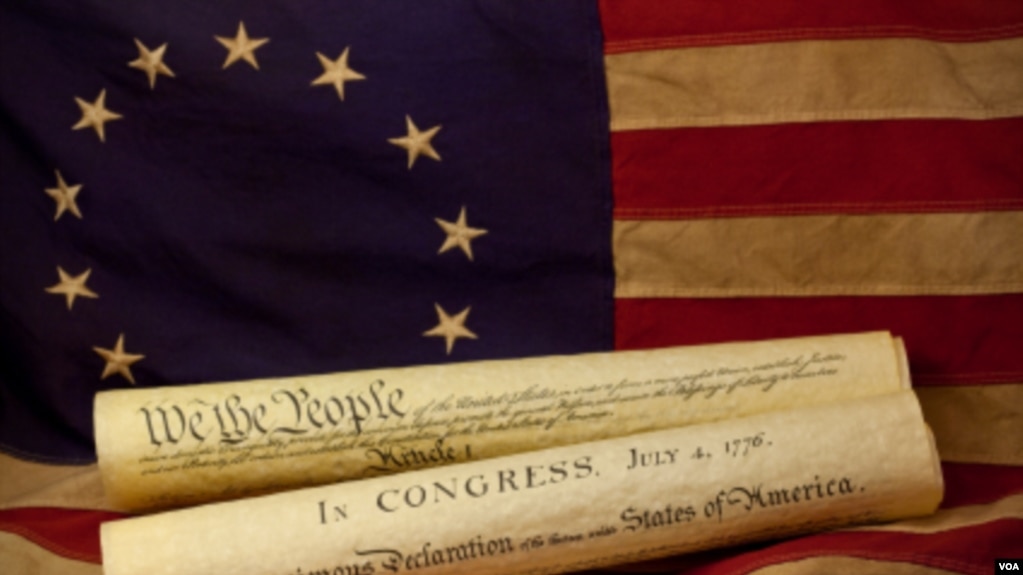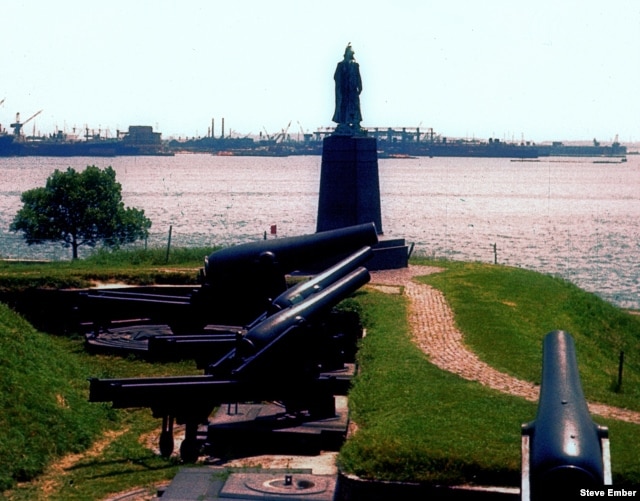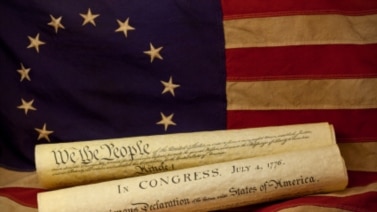
From VOA Learning English, welcome to The Making of a Nation, our weekly program of American history for people learning English. I’m Steve Ember.
Today, we tell the story of how a British attack on Fort McHenry in the port of Baltimore led to "The Star-Spangled Banner," America's national anthem.
In the summer of 1814, British forces attacked Washington, DC. They burned the Capitol building, the White House and other public buildings. Then they withdrew to their ships in the Chesapeake Bay.
British General Robert Ross and Admiral George Cockburn led the attack on Washington. Next they planned to attack Baltimore. But the people of Baltimore expected the attack, and began to prepare for it. Fifty thousand of them built defenses around the city.
The port of Baltimore was protected by Fort McHenry. The guns and cannon of the fort could prevent British ships from reaching the city.
The British began with a land attack against Baltimore. General Ross, Admiral Cockburn and about 4,000 British soldiers landed at North Point, a finger of land reaching into the Chesapeake Bay.
From North Point, it was a march of about 22 kilometers to Baltimore. The British began marching at about seven in the morning. General Ross and Admiral Cockburn stopped their men after an hour. The two commanders and several of their officers rode to a nearby farmhouse and forced the family living there to give them breakfast.
When the British officers finished eating, the farmer asked General Ross where the British were going. "To Baltimore," he answered. The farmer told Ross that he might have some difficulty getting there, because of the city's defenses. But the British general replied, "I will eat supper in Baltimore -- or in hell."
When they returned to the march, Ross and Cockburn moved far in front of the British forces. A group of several hundred Americans opened fire on the British officers. Ross was hit. He died soon afterward.
The Americans retreated, but they slowed the progress of the British soldiers. It was late the next day before the British force arrived to face the army of Americans near Baltimore. The Americans were on high ground and had about 100 cannon to fire down on the British.
The British commander ordered his men to rest for the night. He sent a message to the British warships to attack the city with guns and mortars. Such an attack, he felt, might cause the Americans to fall back. But the British ships had already been firing at Fort McHenry since early morning. The British guns were more powerful than those of the fort. The strength of their guns let the ships fire from so far away that the American guns could not hit them.
Shells and bombs from British mortars fell like rain over Fort McHenry. But few Americans in the fort were hurt or killed. Most of the rockets and shells exploded in the air or missed. Many of them failed to explode.
At the center of the fort flew a large American flag. The flag could be seen by the soldiers defending the city and by the British warships. The flag was also seen by a young American named Francis Scott Key.
Key was a lawyer who had once thought of a life of religious work. He was also a poet and writer. He opposed war. But he loved his country and joined the army in Washington to help defend it.
When the British withdrew from Washington, they took an American doctor named William Beanes with them. Francis Scott Key knew the doctor and asked President Madison to request the British commander to release him. President Madison wrote the request, and Key agreed to carry it to Admiral Cockburn. Key also carried letters from wounded British soldiers in American hospitals. In one of the letters, a British soldier told of the excellent medical care he was being given.
Cockburn agreed to free the doctor after he read the reports that his wounded men were receiving good medical care. But Cockburn would not permit the doctor or Key or a man who came with him to return to land until after the attack.
So Francis Scott Key watched from a British warship as the shells and rockets fell on Fort McHenry.
Years later, he said: "I saw the flag of my country waving over a city — the strength and pride of my native state — a city devoted to plunder and desolation by its assailants. I witnessed the preparation for its assaults. I saw the array of its enemies as they advanced to the attack. I heard the sound of battle; the noise of the conflict fell upon my listening ear, and told me that 'the brave and the free' had met the invaders."

All through the rainy day, the attack continued. Dr. Beanes, watching with Key, had difficulty seeing the flag. He kept asking if the "stars and stripes" still flew above the fort. Until dark, Key could still see it. After that, he could only hope.
Britain tried to land another force of men near the fort. But the Americans heard the boats and fired at them. The landing failed. Shells and rockets continued to rain down on Fort McHenry. At times, the fort's cannon answered. That told Key that the Americans had not surrendered.
The British troops east of Baltimore spent most of the night trying to keep dry. Commanders could not decide if they should attack or retreat. Finally, orders came from the admiral: "Withdraw to your ships." A land attack against Baltimore’s defenses would not be attempted.
At first light of morning, British shells were still bursting in the air over the fort. The flag had holes in it from the British shells. But it still flew. The British shelling stopped at seven o'clock. Key took an old letter from his pocket, and on it he wrote a poem about what he had seen.
Oh, say can you see by the dawn's early light
What so proudly we hailed at the twilight's last gleaming?
Whose broad stripes and bright stars, through the perilous fight
O'er the ramparts we watched were so gallantly streaming?
And the rocket's red glare, the bombs bursting in air,
Gave proof through the night that our flag was still there.
Oh, say does that star-spangled banner yet wave
O'er the land of the free and the home of the brave?
Americans sang these words and remembered the attack on Fort McHenry. Then, in 1931, Congress made the "Star-Spangled Banner" the national anthem of the United States.
The unsuccessful British attack on Baltimore was followed by news that Britain had also suffered a defeat to the north.
British General George Prevost had led 11,000 soldiers south from Montreal to New York. At Plattsburgh, on the western shore of Lake Champlain, his army was opposed by fewer than 4,000 Americans. General Prevost believed he needed to get control of the lake before moving against the American defenders.
He requested the support of four British ships and about 10 gunboats. A similar sized group of American ships also entered the lake. In a fierce battle, the American naval force sank the British ships. The army decided not to attack without naval support. The 11,000 British soldiers turned around and marched back to Montreal.
By the time of these battles, the United States and Britain had already agreed to discuss peace. The peace talks began in the summer at Ghent, in Belgium.
At first the British were in no hurry to sign a peace treaty. They believed their forces would be able to capture parts of the United States.
Britain demanded as a condition for peace that the United States give large areas of its northwest to the Indians. It also said America must give Canada other areas along the border. And Britain would not promise to stop seizing American sailors and putting them in the British navy.
But British policy at the peace talks changed after the battles of Baltimore and Plattsburgh.
The end of the War of 1812 will be our story next week.
(MUSIC)
I’m Steve Ember, inviting you to join us again next week for The Making of a Nation – American History from VOA Learning English.
